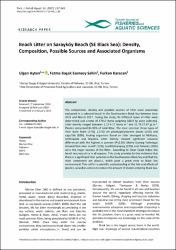| dc.contributor.author | Aytan, Ülgen | |
| dc.contributor.author | Şahin, Fatma Başak Esensoy | |
| dc.contributor.author | Karacan, Furkan | |
| dc.date.accessioned | 2020-12-19T19:35:09Z | |
| dc.date.available | 2020-12-19T19:35:09Z | |
| dc.date.issued | 2020 | |
| dc.identifier.citation | Aytan, Ü., Şahin, B.E. & Karacan, F. (2020). Beach Litter on Saraykoy Beach (SE Black Sea): Density, Composition, Possible Sources and Associated Organisms. Turkish Journal of Fisheries and Aquatic Sciences, 20(2), 137-145. https://doi.org/10.4194/1303-2712-v20_2_06 | en_US |
| dc.identifier.issn | 1303-2712 | |
| dc.identifier.issn | 2149-181X | |
| dc.identifier.uri | https://doi.org/10.4194/1303-2712-v20_2_06 | |
| dc.identifier.uri | https://hdl.handle.net/11436/1239 | |
| dc.description | NEMLIOGLU, SEMIH/0000-0002-9938-4651 | en_US |
| dc.description | WOS: 000475948000006 | en_US |
| dc.description.abstract | The composition, density and possible sources of litter were seasonally evaluated in a selected beach in the Southeastern Black Sea between June 2016 and March 2017. During the study, 84 different types of litter were determined and a total of 17015 items weighing 168.9 kg were collected. Litter density ranged between 1.22-4.17 items.m(-2) and 11.78-37.47 gr.m(-2). Plastics comprised 84-91% of total litter. the most common three types of litter were foam (17%), 2.5-50 cm plastic/polystyrene pieces (15%) and caps/lids (10%). Fouling organisms found on litter belonged to Mollusca, Arthropoda and Bryozoa. Litter density showed significant seasonal differences with the highest in summer (P<0.05). Matrix Scoring Technique showed that river runoff (22%), landfill/dumping (21%) and fisheries (18%) were the major sources of the litter. According to Clean Coast Index, the beach was very dirty in all seasons. This study provides further evidence that there is a significant litter pollution in the Southeastern Black Sea and that the main component are plastics, which pose a great treat to Black Sea environment. This call for a scientific understanding of the fate and effects of plastics, as well as actions to reduce the amount of plastics entering Black Sea. | en_US |
| dc.language.iso | eng | en_US |
| dc.publisher | Central Fisheries Research Inst | en_US |
| dc.rights | info:eu-repo/semantics/openAccess | en_US |
| dc.subject | Plastic | en_US |
| dc.subject | Marine litter | en_US |
| dc.subject | Pollution | en_US |
| dc.subject | MSFD | en_US |
| dc.subject | Black Sea | en_US |
| dc.title | Beach litter on Saraykoy beach (SE Black Sea): density, composition, possible sources and associated organisms | en_US |
| dc.type | article | en_US |
| dc.contributor.department | RTEÜ, Su Ürünleri Fakültesi, Su Ürünleri Temel Bilimler Bölümü | en_US |
| dc.contributor.institutionauthor | Aytan, Ülgen | |
| dc.contributor.institutionauthor | Şahin, Fatma Başak Esensoy | |
| dc.identifier.doi | 10.4194/1303-2712-v20_2_06 | |
| dc.identifier.volume | 20 | en_US |
| dc.identifier.issue | 2 | en_US |
| dc.identifier.startpage | 137 | en_US |
| dc.identifier.endpage | 145 | en_US |
| dc.ri.edit | oa | en_US |
| dc.relation.journal | Turkish Journal of Fisheries and Aquatic Sciences | en_US |
| dc.relation.publicationcategory | Makale - Uluslararası Hakemli Dergi - Kurum Öğretim Elemanı | en_US |


















